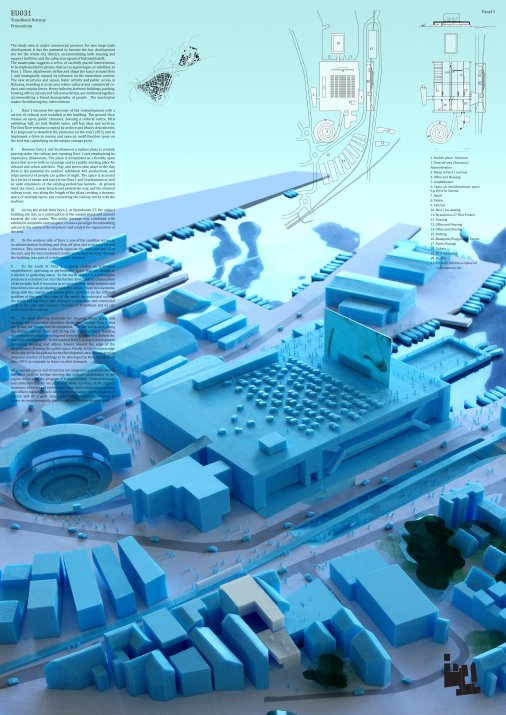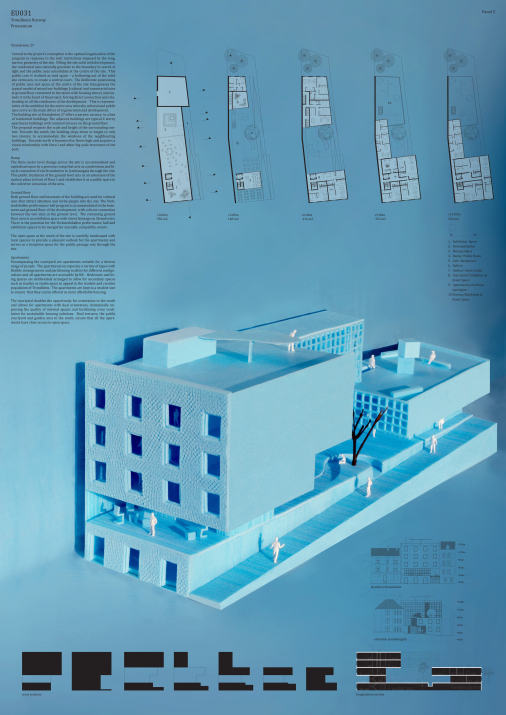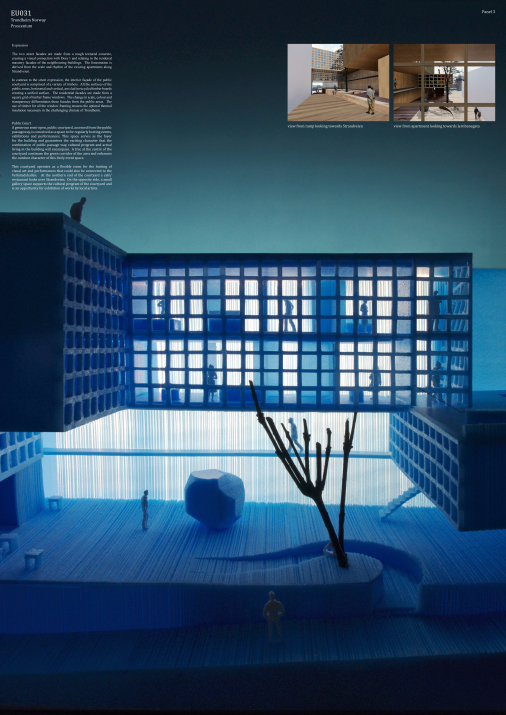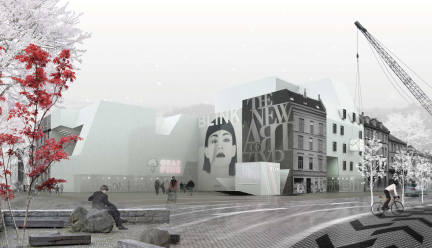Project:
Proscenium
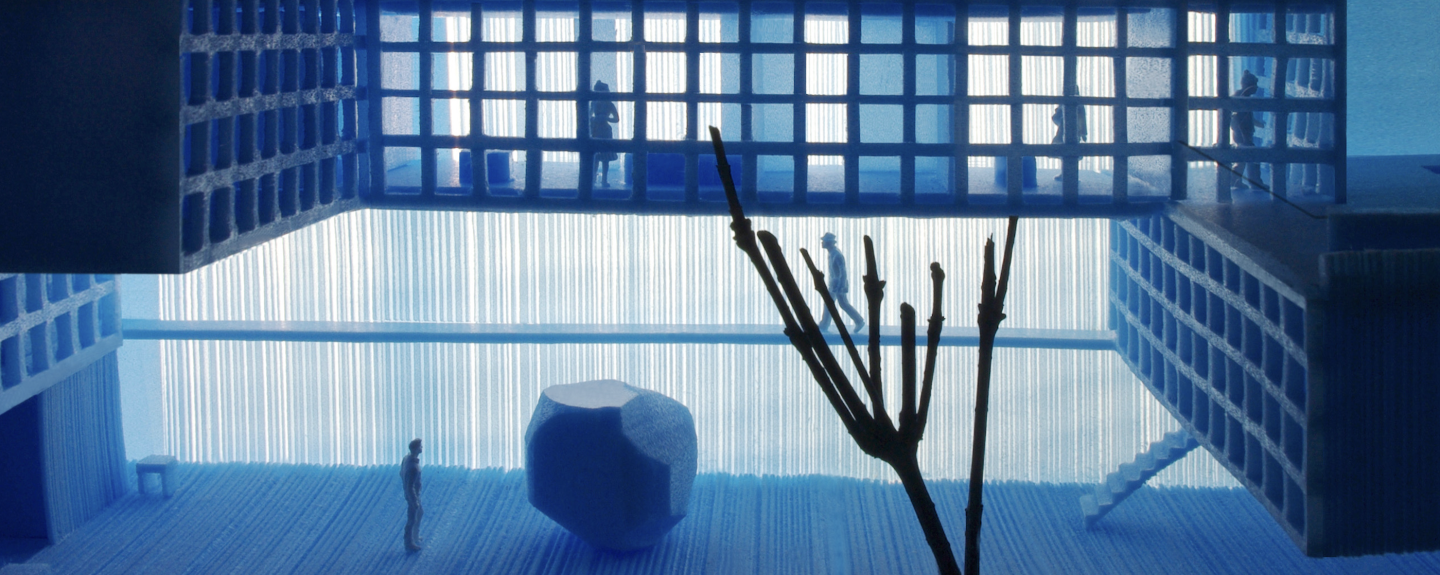
About
-
The study area is under commercial pressure for new large-scale development. It has the potential to become the key development site for the whole city district, accommodating both housing and support facilities, and the cultural program of Kultimathule®.
The master plan suggests a series of carefully placed interventions, to be implemented in phases that act as appendages, or satellites, to Dora 1. These attachments define and shape the space around Dora 1 and strategically expand its influence on the immediate context. The new structures and spaces foster activity and public access in Nyhavna, branding it as an area where cultural and commercial environments co-exist and join forces. Heavy industry, harbour buildings, parking, housing, offices, leisure and cultural activities are combined together accommodating a broad demographic of people. The master plan makes the following key interventions:
Dora 1 becomes the epicenter of the redevelopment with a variety of cultural uses installed in the building. The ground floor retains an open, public character, housing a cultural centre, MLA exhibition hall, art hall, flexible space, café bar, shop and services. The first floor remains occupied by archive and library depositories. It is proposed to demolish the extension on the roof (2015) and to implement a drive-in cinema and open air multi-function space on the roof top, capitalizing on the unique vantage point.
Between Dora 1 and Svartlamoen a sunken plaza is created, passing under the railway and exposing Dora 1 emphasising its impressive dimensions. The plaza is formulated as a flexible, open space that serves both as a passage and as a public meeting place for cultural and urban activities; play and sports take place in the day, there is the potential for outdoor exhibitions and productions, and large amounts of people can gather there at night. The space is accessed by a series of ramps and stairs from Dora 1 and Svartlamoen as well as wide extensions of the existing pedestrian tunnels. At ground level, the street, a wide bicycle and pedestrian way, and the retained railway track run along the length of the plaza creating a dynamic space of multiple layers and connecting the railway tracks with the seafront.
Across the street from Dora 1, at Strandveien, the subject building site acts as a continuation of the sunken plaza and extends towards the city center. This public passage way, combined with exhibition and public central space, works to embed culture at the centre of the development, and serves as a catalyst for regeneration of the area.
On the western side of Dora 1, one of the satellites serves as an administration building, drop-off area and second entrance. This entrance is directly opposite the main entrance “A” on the east, and the two combined transform the internal road through the building into part of a wider public network.
To the south of Dora 1, a spiral creates an archetypal amphitheatre, operating as performance space that can double as a market or gathering space. To the north of Dora 1, a rectangular pontoon is extended out into the harbour. Envisaged as a continuation of the torpedo hall, it functions as an open air pool in the summer and transforms into an ice skating rink in the winter. These two elements, along with the cinema and sunken plaza, capitalise on the different qualities of the area: the water to the north, the industrial scale to the south, infrastructure and transport connections and residential scale to the east, and complete visibility of Trondheim and its city centre from the roof top.
To meet growing demands for housing, office space and parking, the master plan identifies three sites around Dora 1 that are prime for intensified development. To the north-east, along the former railway lines and facing the water, a linear building accommodates offices, housing and leisure facilities and defines the end of the development. To the south of Dora 1, a ring of development containing housing and offices hovers around the edge of the amphitheatre, framing the public space. Finally, at the southern edge of the site, as the final phase for the development area, the master plan proposes a series of buildings to be developed by Rom Eiendom AS after 2015, in response to future market demands.
All proposed spaces and structures are integrated and work towards the same goal; to further develop the cultural cooperation in the region in line with the program of Kultimathule®. Cultural heritage and contemporary art are promoted, while activities of the regional museums, libraries and archives are integrated with housing, parking and offices. This marks the beginning of a new strategy based on culture and its organic integration with commercial interests to create environmentally and socially sustainable development.
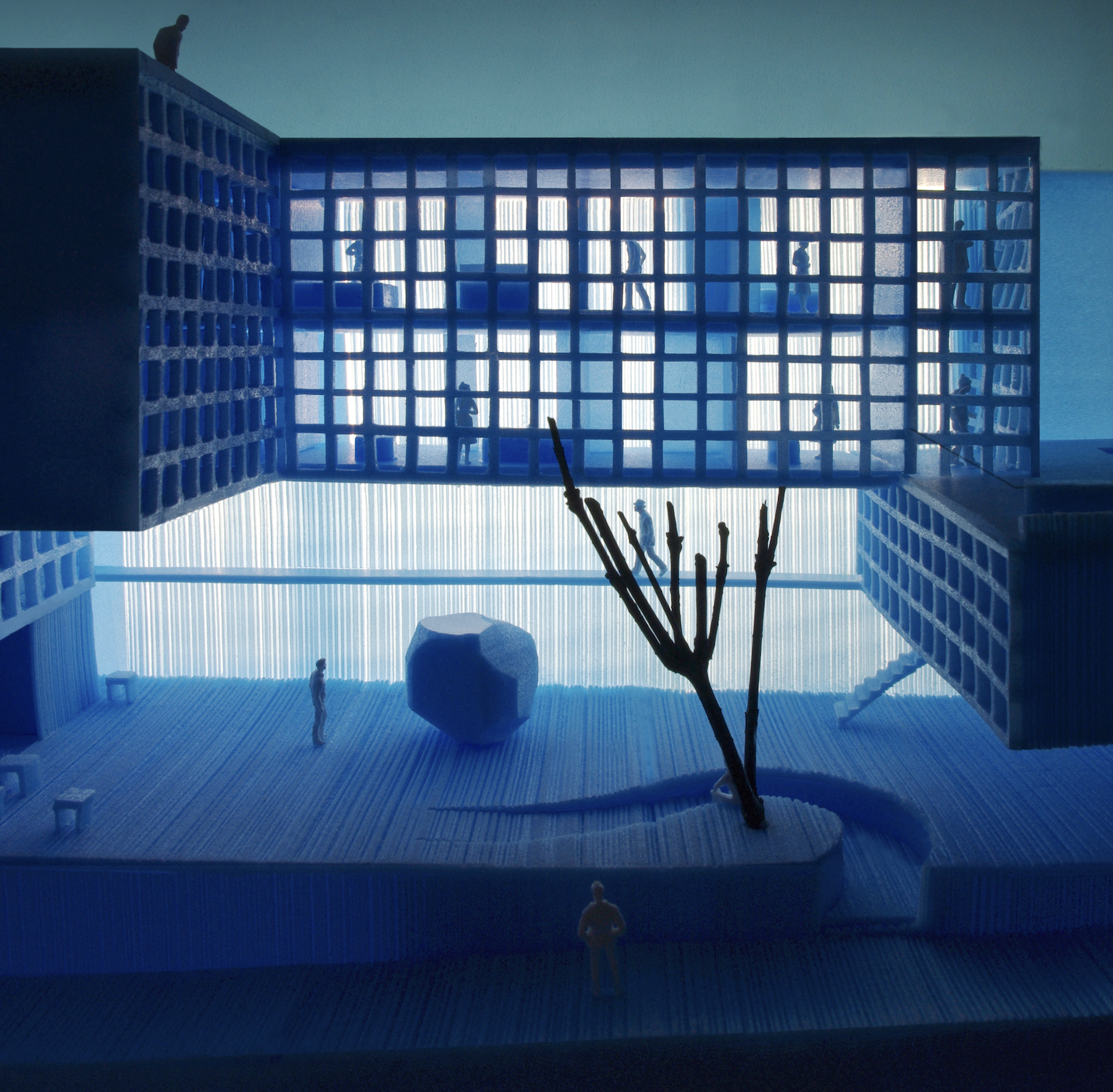
Strandveien 27
Central to the project’s conception is the optimal organisation of the programme in response to the tacit restrictions imposed by the long, narrow geometry of the site. Filling the site solid with development, the residential uses naturally gravitate to the boundary in search of light and the public uses consolidate at the centre of the site. This public core is realized as void space – a hollowing out of the solid site extrusion to create a central court. The deliberate positioning of public uses and space at the centre of the site transgresses the typical model of mixed use buildings (cultural and commercial uses connected to the street at the ground floor with housing above) and embeds it in the heart of the project, forcing direct connection and relationship to all the residences of the development. This is representative of the ambition for the entire area whereby cultural and public uses serve as the main driver of regeneration and development.The building site at Strandveien 27 offers a narrow vacancy in a line of residential buildings. The adjacent buildings are typical four storey apartment buildings with commercial uses on the ground floor.
The proposal respects the scale and height of the surrounding context. Towards the south, the building steps down in height to only two storeys to accommodate the windows of the neighbouring buildings. Towards the north it becomes five floors high, acquiring a visual relationship with Dora I and other big scale structures of the port.
Ramp
The three meter level change across the site is accommodated and capitalised on by a generous ramp that acts as a pedestrian and bicycle connection from Strandveien to Jernbanegata through the site. This public treatment of the ground level acts as an extension of the sunken plaza in front of Dora 1 and establishes it as a public space in the collective consciousness of the area.Ground floor
Both the ground floor and basement of the building are designated for cultural uses that attract attention and invite people into the site. The Verkstedshallen performance hall programme is accommodated in the basement and ground floor of the development, with a direct connection between the two sites at the ground level. The remaining ground floor area is an exhibition space with street frontage on Strandveien. There also exists the potential for the Verkstedshallen performance hall and exhibition spaces to be merged for mutually compatible events.The open space at the south of the site is carefully landscaped with local species to provide a pleasant view for the apartments and a reception space for the public passage way through the site.
Apartments
Encompassing the courtyard are apartments suitable for a diverse range of people. The apartments incorporate a variety of types with flexible arrangements and partitioning to allow for different configurations. All apartments are accessible by lift. Bedrooms and living spaces are deliberately arranged to allow for secondary spaces, such as studies or studio space, to appeal to the student and creative population of Trondheim.The apartments are kept to a modest size to ensure that they can be kept within an affordable price range.
The courtyard allows for additional exposure to the south, giving the apartments a dual orientation, dramatically improving the quality of internal spaces and facilitating cross ventilation for sustainable housing solutions. Roof terraces, the public courtyard and garden area to the south, ensure that all the apartments have close access to open space.
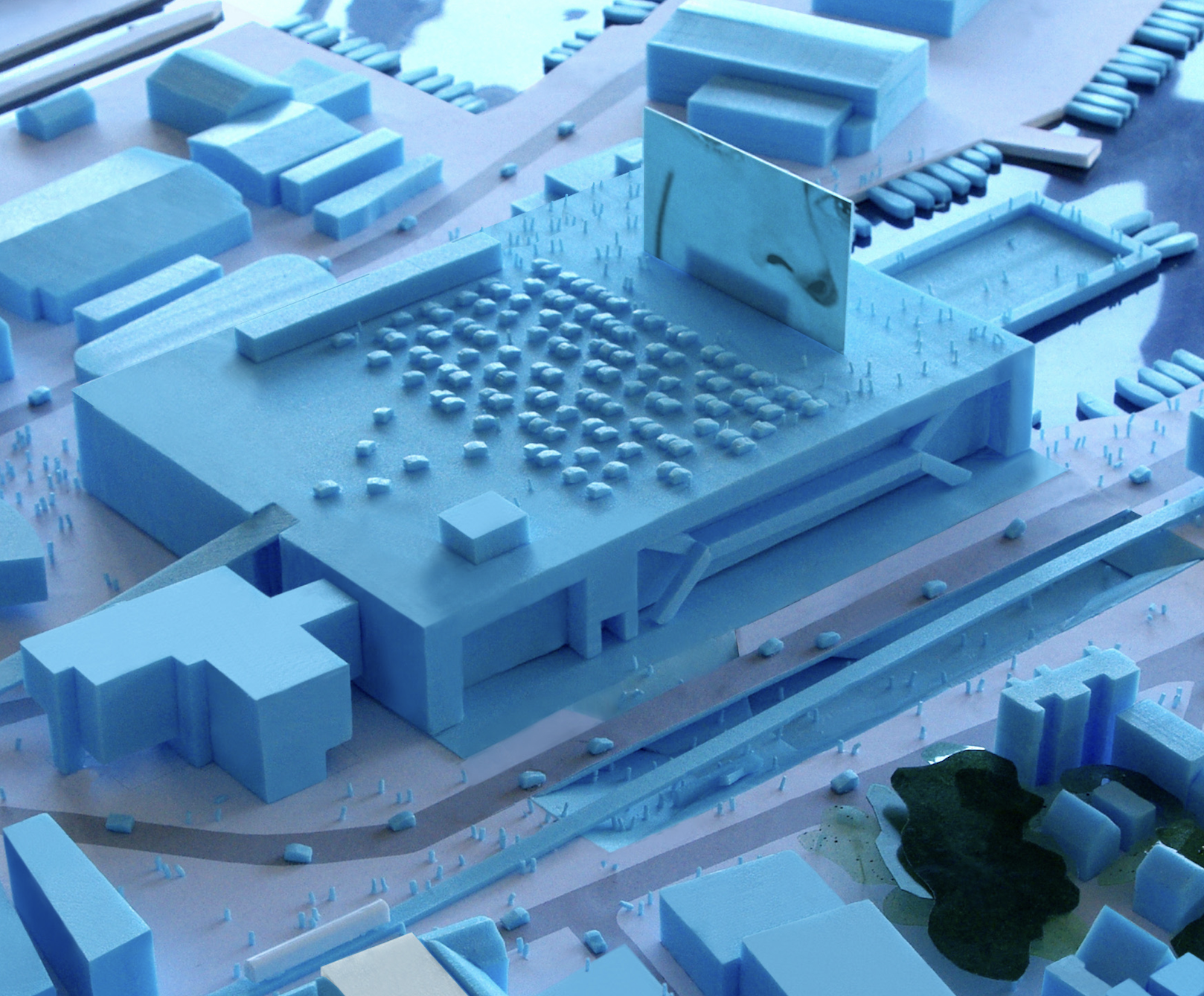
Expression
The two street façades are made from a rough textured concrete, creating a visual connection with Dora 1 and relating to the rendered masonry façades of the neighbouring buildings. The fenestration is derived from the scale and rhythm of the existing apartments along Strandveien.In contrast to the street expression, the interior façade of the public courtyard is comprised of a variety of timbers. All the surfaces of the public zones, horizontal and vertical, are clad in recycled timber boards creating a unified surface. The residential façades are made from a square grid of timber frame windows. The change in scale, colour and transparency differentiate these façades from the public areas. The use of timber for all the window framing ensures the optimal thermal insulation necessary in the challenging climate of Trondheim.
Public Court
A generous, semi-open public courtyard, accessed from the public passageway, is conceived as a space for hosting regular events, exhibitions and performances. This space serves as the foyer for the building and guarantees the exciting character that the combination of public passage way, cultural program and actual living in the building will encompass. A tree at the centre of the courtyard continues the green corridor of the area and enhances the outdoor character of this lively event space.This courtyard operates as a flexible room for the hosting of visual art and performances that could also be connected to the Verkstedshallen. At the northern end of the courtyard a café/restaurant looks over Strandveien. On the opposite side, a small gallery space supports the cultural program of the courtyard and provides an opportunity for exhibitions by local artists.
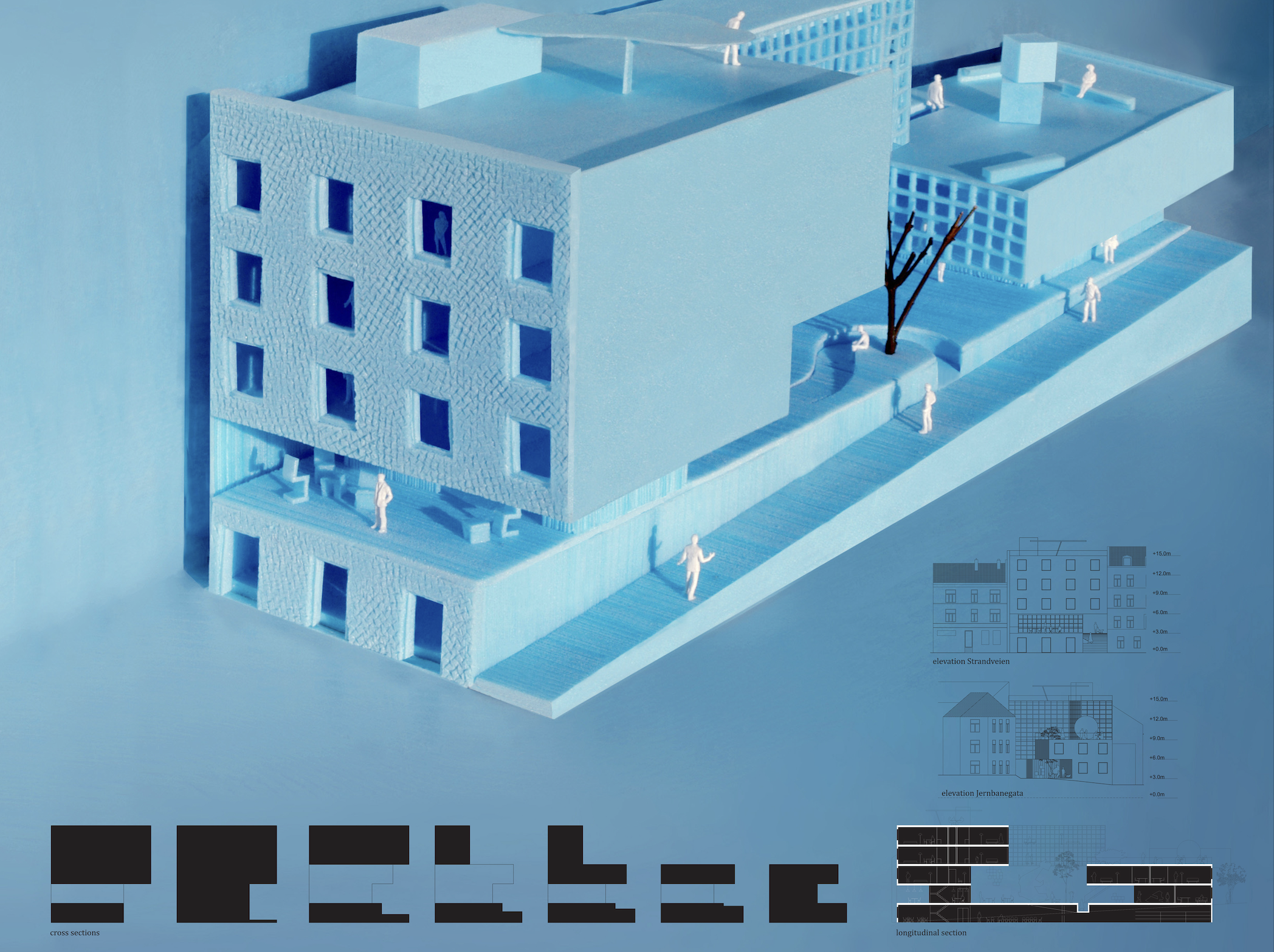
-
For the building site at Strandveien 27, the project Proscenium proposed a permeable building with a public passage. A ramp connects the different levels of Strandveien and Jernbanegata. Inside the porous structure, the ramp gives access to a public courtyard with a small gallery, a café and a balcony for visual connection to Strandveien. All apartments are accessed via the courtyard as well. The strong contrast of the rather closed and brute outer façades, with the wooden and open inner façade, turns the courtyard into a surprising discovery at the core of the site.
The jury granted the first prize to the proposal Proscenium for their negotiation with the challenges at hand: the long narrow site, the large amount of restrictions dictated by the surrounding housing blocks, the urban connections and the extension of the cultural programme . Their simple combination of a long public ramp and the inner courtyard is, in the jury’s opinion, the right approach for this site. The ramp provides access for pedestrians and cyclists, while the courtyard ends in an “urban balcony” with a view of Dora I and the surrounding harbour area. With spatial understanding, the project negotiates carefully the demands for programmatic density, public permeability and natural light for the private homes on the narrow site. It concludes with a solid proposal that offers sculptural and spatial qualities.
Connecting the existing multipurpose space to the new public programme on the ground floor is a good approach, however, the jury finds the spatial connection to the programme situated on the first floor (including the courtyard), to be lacking. The outer façade and the layout of the apartments should be further developed to improve the quality of the project.
-
The team is a collaboration between Point supreme architects and alex gerousis.
Point Supreme Architects
Point Supreme Architects is based in Athens and led by three partners of diverse backgrounds: Marianna Rentzou, Beth Hughes and Konstantinos Pantazis. Prior to forming Point Su- preme the partners worked for a variety of international firms including OMA/Rem Koolhaas and MVRDV in the Netherlands, Jun Aoki in Tokyo and 51N4E in Brussels.
Alexandros Gerousis
Born in Athens, Greece, Alexandros Gerousis graduated from the Architecture School of the University of Patras in 2006. Fol- lowing university he worked for JDS Architects, Copenhagen for two years, and most recently has established his own office in Athens.CONTACT:
Point Supreme Architects
(Marianna Rentzou, Beth Hughes)
Tel.: +30 210 52 36 530 / +30 6970 199 702
Leonidou 25, 10436, Athens Metaxourgio, GREECE
www.pointsupreme.com
info@pointsupreme.comAlex Gerousis
Tel.: +30 210 52 36 530 / +30 6937 249 092
Leonidou 25, 10436, Athens Metaxourgio, GREECE
Email: gerouz@gmail.com
